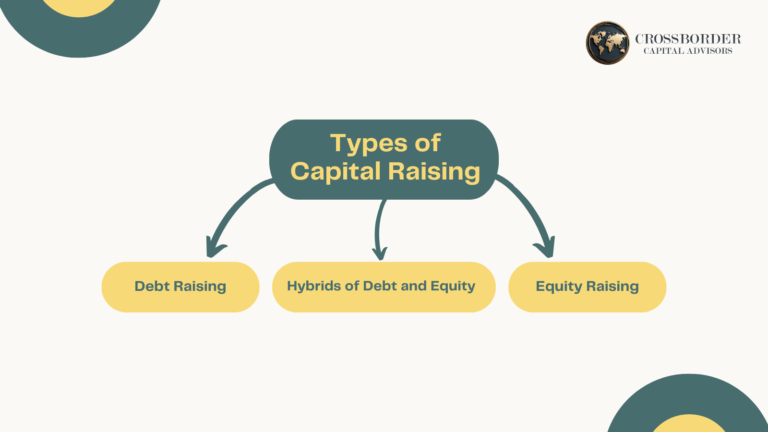What is Capital Raising and Types of Capital Raising

In recent times, the environment for companies seeking to raise capital has become particularly favorable. With historically low interest rates, significant government economic interventions, and a growing variety of funding sources, companies have numerous options for securing the funds they need.
What is Capital Raising?
Capital raising is the process by which a company secures funds from external sources to support its strategic objectives, such as expanding operations, investing in new projects, or engaging in mergers and acquisitions. This influx of capital is crucial for companies aiming to grow, innovate, or sustain their business during economic fluctuations.
Types of Capital Raising
Companies can raise capital through three primary methods: debt, equity, or a hybrid of the two.
1. Debt Raising
Debt raising involves borrowing funds that must be repaid over time with interest. Traditionally, banks and public debt markets have been the main sources of loans, but now a wider range of financial institutions, including private equity funds, participate in lending.
Types of Debt
- Secured Debt: Loans backed by collateral, resulting in lower interest rates due to reduced risk for lenders.
- Unsecured Debt: Loans without collateral, where interest rates are based on the company’s credit history.
- Tax-Exempt Corporate Debt: Debt that offers tax benefits, often linked to projects with societal benefits, such as sustainability initiatives.
- Convertible Debt: Debt that can be converted into equity under certain conditions, offering a blend of debt and equity characteristics.
Pros and Cons of Debt Raising
Pros:
- Quick access to necessary funds.
- Favorable interest rates in low-rate environments.
- Predictable interest payments aid in financial planning.
- Interest payments are tax-deductible.
Cons:
- Can negatively impact the company’s credit rating.
- May encourage borrowing even when unnecessary.
- Obligation to repay regardless of business performance.
- Limits strategic flexibility due to debt on the balance sheet.
2. Equity Raising
Equity raising involves selling ownership stakes in the company to investors. This method does not require repayment, making it an attractive option for companies with strong growth potential but uncertain short-term revenues.
Types of Equity Raising
- Crowdfunding: Raising small amounts from a large number of individuals.
- Seed Financing: Early-stage funding to help a company get started.
- Angel Financing: Investments from wealthy individuals in exchange for equity.
- Venture Capital: Investments from funds in high-potential early-stage companies.
- Private Equity: Investments in more mature companies to facilitate expansion or restructuring.
- Public Capital Markets: Selling shares through public stock exchanges.
Pros and Cons of Equity Raising
Pros:
- Access to expert advice from experienced investors.
- No regular interest repayments.
- Ability to set company valuation.
- Typically lower risk compared to debt raising.
Cons:
- Dilution of existing ownership and control.
- Potential requirements for investor approval on major decisions.
- Possible friction with external investors.
- Shared upside potential with new investors.
3. Hybrids of Debt and Equity
Hybrid financing combines elements of both debt and equity, offering flexible arrangements that can benefit both the company and investors. Examples include convertible bonds, which begin as debt but can convert to equity under specified conditions.
Pros and Cons of Hybrids
Pros:
- Flexibility in arrangements benefiting both parties.
- Lower risk profile for both companies and investors.
- Access to a broader investor base.
- Enables investors to diversify with a mix of fixed income and equity.
Cons:
- More complex than purely debt or equity financing.
- Often structured to favor investors over the company.

Capital Raising FAQ
What are the advantages and disadvantages of raising capital?
Advantages of Capital Raising:
- Provides necessary funds for expansion and growth.
- Enhances financial stability.
- Offers greater flexibility in managing operations.
- Attracts talent and facilitates partnerships.
- Improves relationships with investors.
Disadvantages of Capital Raising:
- Dilutes existing shareholder ownership.
- Increases financial commitments.
- Can be costly and complex to execute.
- Risks associated with timing and market conditions.
In summary, capital raising is essential for companies aiming to achieve their strategic goals. By understanding the different methods and weighing their respective advantages and disadvantages, businesses can make informed decisions that support their growth and financial health.
